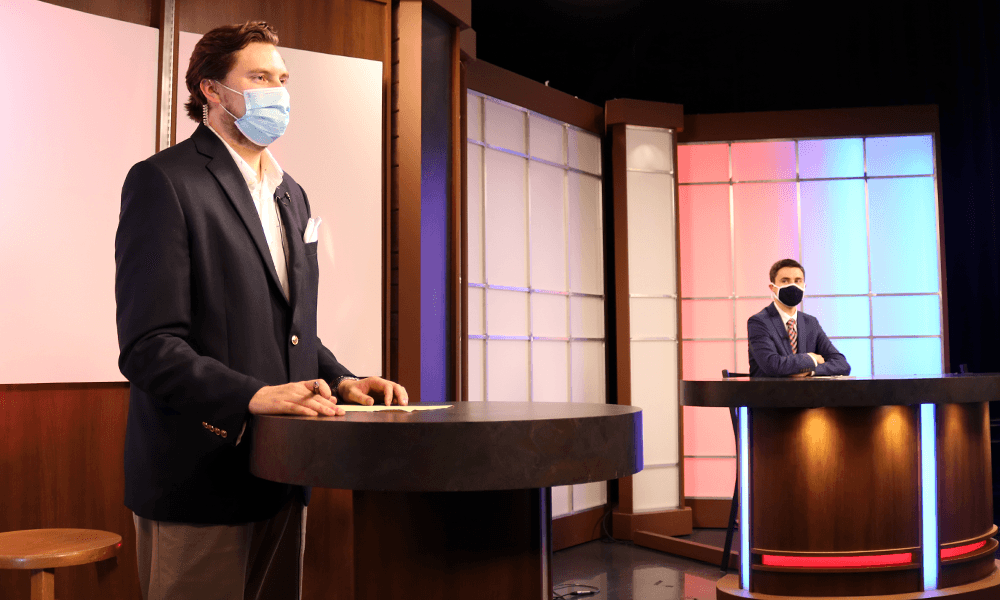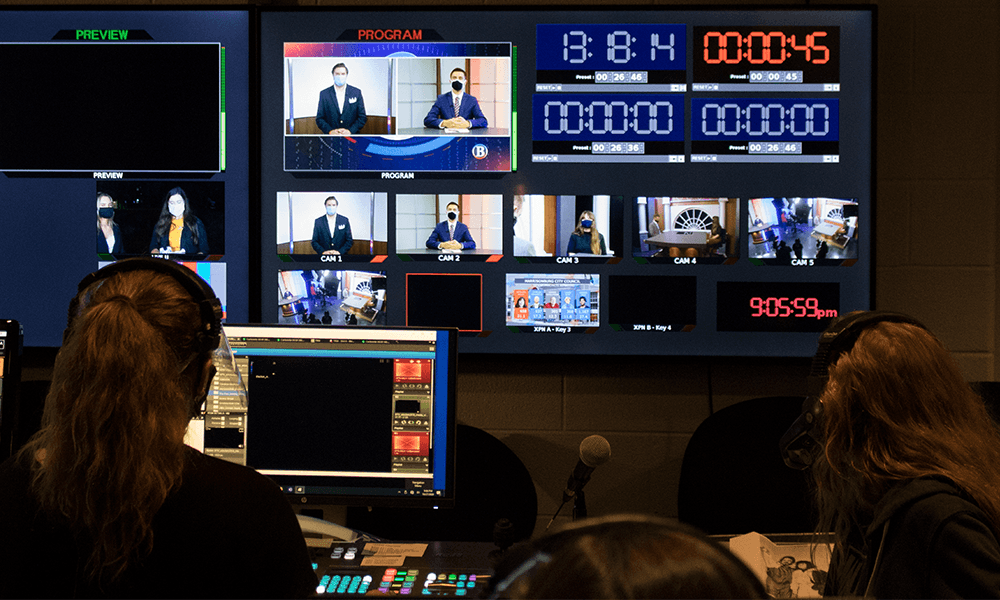SMAD students and faculty explore ways to cover 2020 elections
Students across concentrations participate in multi-media coverage
Media Arts and Design
By Charlotte Matherly, staff writer
SMAD students and professors working across three courses this fall have been studying and covering the local, state and national candidates and campaigns through various media.
To help the community participate and better understand the U.S. democratic process, those classes are producing voter guides and planned live coverage on Election Night.
SMAD 421 aims to educate voters through election guide magazine
One upper-level journalism course is producing a magazine with feature stories and different aspects of voting, politics and the election. The magazine launched online Oct. 27. During the rest of the semester, each student will produce his or her own print version of the voter guide that’s been posted online.
Brad Jenkins, who teaches journalism courses in SMAD and is the general manager of The Breeze, teaches the SMAD 421 course.
Jenkins said the magazine includes Q and A’s with the candidates, some published online as videos, and some in the written form. It also contains information about the Harrisonburg City Council race, and, on a more national scale, the races for the U.S. House of Representatives, the U.S. Senate and the presidency.
As he guides students through the process of making a magazine — from idea to publication — Jenkins said he realized he’d never done a voter guide with that class before.
“I’m teaching them … all that entails, whether you’re a writer, photographer, videographer or the editor,” Jenkins said. “It seemed to me that I could do all that with a very relevant topic, which would also allow us to be able to put out an actual publication that can maybe help people.”
Sabriya McKoy, a senior SMAD major with a concentration in journalism, is a feature writer for the magazine. She said she’s written three stories for it, covering how Harrisonburg has transitioned into a Democratic city surrounded by the Republican-majority Rockingham County and how the JMU Civic center is helping Dukes get involved and engaged in politics. She also reported and wrote a candidate profile for U.S. Rep. Ben Cline, the Republican congressman from Virginia’s 6th district who is seeking his second term, and Democratic challenger Nicholas Betts, who’s running against Cline.
McKoy said her interest in politics, particularly as a minority student in a predominantly white institution, really clicked when she took the “media and politics” (SMAD 472) class last summer. In the feature magazine class, she said, she’s learning how to channel her passion for politics.
“It’s helped me put those thoughts into a format where it’s going to help other students,” McKoy said. “It’s not just me putting my thoughts on paper, but now, it’s like, how can I tell this message and communicate it to those like me and even those that aren’t like me?”

Students in the SMAD 497 class rehearse for their Nov. 3 Election Night broadcast.
SMAD 497 to produce election night coverage through Breeze TV
A mix of SMAD students across three concentrations have teamed up to cover local and statewide campaigns this fall in preparation for broadcasting results on Nov. 3 through The Breeze on Facebook Live and producing another follow-up analysis program Nov. 10.
That course, SMAD 497, has 16 students, including upper-level journalism students, Digital Video and Cinema students who are handling the Election Night and analysis shows’ production and one Creative Advertising student, who has an interest in politics and visual design. The 497 course is co-taught by professors Joe Hinshaw, Ryan Parkhurst and Ryan Alessi.
“We have a lot of high quality students in that class that are really motivated to do a good job, so it’s always fun working with students who are motivated to do good work,” Parkhurst said. “It’s been a blast. It’s honestly just super fun, and because it’s fun, an easy class to teach.”
This specific course has never before been offered at JMU. Parkhurst said the class was designed with the intention of gathering skilled SMAD students to prepare and produce national, state and local election coverage in the Alison Parker studio, located in the basement of Harrison Hall.
The class is split into three sections. One group of students will be acting as field reporters, led by Alessi. A second group of five students, led by Hinshaw, will make a graphics package for election night, which includes all the graphics of statistics, polling, results, and more shown on the television throughout broadcast. A third team of producers is led by Parkhurst and will be based in the SMAD studio. They organize the two-and-a-half hour show, deciding what stories will be covered and what results will be shown in a specific order.
The show will be broadcast Nov. 3 on every platform that Breeze TV uses, including Facebook Live, campus cable channel 35, and The Breeze’s homepage.
Parkhurst also said the course aims to challenge the students he referred to as the “cream of the crop,” as well as giving them a broader perspective toward journalism. It’s forced them, he said, to go out into the Harrisonburg community to cover stories that may be different from what they’ve done in the past.
“There’s always been a disconnect, I think, for students between what they do as journalists on campus, you know, there’s kind of this thought process [of] ‘I’m just studying journalism, I’m not actually doing journalism,’” Parkhurst said. “This class kind of gives them the opportunity to do real journalism and to be critiqued on it.”
Parkhurst said he hopes the class can provide students with the realization of the important place journalism holds in society.
“We report and hold the powerful accountable,” Parkhurst said. “We have a real important and meaningful function in a democracy, and doing a class like this really hammers that home to students, that what you … report on and how you report on it is incredibly meaningful because you’re informing the American citizenry.”
Brice Estes, a senior SMAD major with a journalism concentration, is working with Alessi as one of the students reporting in the field. Estes said she’ll be based at the Democratic watch party, where three of the city council candidates, Charles Hendrix, Laura Dent and Mayor Deanna Reed, will be watching the results. Other students will be assigned to get reaction from the other two council candidates, independent George Hirschmann and Republican candidate Kathleen Kelley.
Estes also said she’s working on two stories for election night coverage. She’s writing a profile on Laura Dent and a feature on how the role of poll workers has changed during the pandemic, exploring the concerns they may have going into the 2020 election.
As an aspiring political reporter, Estes said this class is right up her alley and feels like SMAD 497 was created for her niche interests. She’s not a broadcast reporter, Estes said, so this will be her first time on camera.
“It’s a really great experience, just because I think that journalism is changing,” Estes said. “You’re going to need to have experience in all facets of journalism nowadays, and this is just another expansion in my repertoire.”
One student on the graphics team working with Hinshaw, Ivan Jackson, is a senior SMAD major with a concentration in DVC. Jackson said he’s been designing packages for the broadcast that include lower thirds and full screen graphics. As for his role during the show, Jackson said he will be helping coordinate on-location reporting at either the Democratic or Republican headquarters.
In producing an election results broadcast, Jackson said, they can only plan for so much. He said he doesn’t know what will happen once results begin to pour in, and the students need to prepare and practice for the unknown.
Jackson said he thinks it's an important project — not just for the 16 students in the class, but for the community.
“You see a lot of attention on national races … but it’s the local city council, school board — those kinds of things that you don’t see covered nearly as well,” Jackson said. “Our focus is to make sure our constituency is all informed and balanced and making sure we’re covering the elections that are really important but not a lot of people know about them.”
JMU X-Labs course examines different angles of election
Adrienne Hooker, an assistant professor in the SMAD department, is teaching a JMU X-Labs course, Hacking for Democracy. Hooker co-teaches the class with Dr. Carah Ong Whaley, the associate director of JMU Civic, and Cathy Copeland, an adjunct professor in the WRTC department.
Hooker said Hacking for Democracy focuses on scholarly readings and reactions, then taking that knowledge and applying it. The class produced a voter guide for the JMU Civic website. The students are split into four teams, instructed to interview candidates and campaigns on all levels, from presidential to the school board.
For each candidate, the voter guide includes a basic biography, education and experience, the candidate’s platform and that person’s stances on the issues. Hooker said they received one response from a presidential campaign, and students even interviewed Jo Jorgensen, the Libertarian candidate.
Hooker said the class has proven instrumental in educating students about democracy. She said getting involved in elections is important in every season — not just during the presidential elections every four years.
“It’s one of the three tenets of James Madison University, is civic engagement,” she said. “So, I think the more we can do that in specific classes but also to help support what the [JMU Civic] center is doing right, I think that’s why I’m a part of it.”
Hooker said she also gives a bonus assignment to many of her SMAD students. She encourages them to participate in the election further than just voting — students can receive extra credit by text banking for the candidate or organization of their choice, driving people to the polls, and getting involved in other ways throughout the election.
“I think every college student needs to be aware of that, you know, your voice counts and you need to participate,” Hooker said. “The more that faculty can sort of show them that this isn’t anything intimidating, and it’s also not as horrible as what we all think it is — I mean the worst thing you could do is not participate.”
